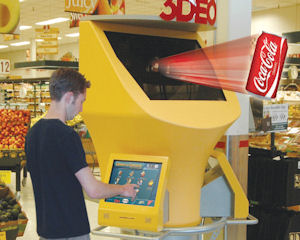After laying low in 2011, Provision Holdings Inc. has big plans this year: to launch its 3D displays into two national pharmacy and convenience store chains. Beginning this month, shoppers in up to 4,800 Rite Aid pharmacies nationwide and 480 Circle K convenience stores in the Western U.S. will see Provision’s 3D displays. The Chatsworth-based company is on the forefront of 3D advertising with proprietary technology that projects holographic images of consumer products from kiosks to entice shoppers to take a coupon, or join a sweepstakes or contest. Best of all, says President and CEO Curt Thornton, the Provision method does not require special glasses to see the 3D image or cause headaches or dizziness. “Because they are holographic and floating in space, those are unique components that clearly differentiate us from what else is in the marketplace called 3D,” he said. Provision’s plans come at a time of double-digit growth in the niche industry of 3D displays, digital billboards and signage. The industry had U.S. sales of $2.07 billion in 2010 and is expected to grow by 16 percent in 2011, according to a report from PQ Media, an emerging media research and econometrics firm based in Connecticut. Advertisers are migrating away from traditional advertising venues and moving toward the new technologies to reach consumers where they shop and entertain themselves. Retail is the second biggest market for 3D digital display technologies, though it’s a challenging market. (Movie theaters are the top market). Consumers are bombarded with many types of images and messages, so compelling content is required to snag their attention, said Patrick Quinn, president and CEO of PQMedia. “The whole point is capturing demographics for an extended period of time,” Quinn said. “You can target messages to get them to make a purchase or (reinforce) the decision to come back again.” Provision’s plans for 2012 build on previous efforts to gain ground in the retail market — efforts that fell short. In 2008, Provision installed its displays in Fred Meyer grocery stores in Portland, Ore. In Southern California, Provision located the kiosks in 47 Hispanic grocery stores belonging to four different chains. The number of stores, however, was not enough and Portland wasn’t a major market coveted by advertisers, Thornton said. So Thornton took steps to increase the number of stores and pick locations in markets desirable to advertisers. In addition to its plans to install displays in Rite Aid and Circle K stores, Provision in October signed an agreement with Premier Retail Networks to provide ad sales for the 3D kiosk network. Attempts to reach a representative from PRN were not successful. Thornton outlined the 2012 Provision strategy in a letter to shareholders, which is posted on the company’s website. Citing confidentiality agreements, Thornton would not discuss the company’s strategy beyond what was in the letter. “For strategic reasons and competitive reasons we were only able to share what little information we did,” Thornton said. Provision trades on the Pink Sheets, although it has fallen behind with filing quarterly earning statements with the U.S. Securities and Exchange Commission. The company expects to catch up with the filings by the end of January, Thornton stated in the letter. In the last filing through the second quarter ending Dec. 31, 2010, Provision reported a net loss of $802,289, or 2 cents per diluted share on revenues of $186,788. That narrows the net loss from the same period in 2009 when the company reported a loss of $1,028,533, or 4 cents per diluted share, on revenues of $80,995. Provision has received private capital to finance the Rite Aid and Circle K installations. An unnamed venture capital partner is financing the Rite Aid roll-out and provided $250,000 for the first 10 stores, according to Thornton’s letter. Lifestyle Ventures will invest $3 million for the Circle K network with a small portion already given to Provision to manufacture the displays for three stores.
